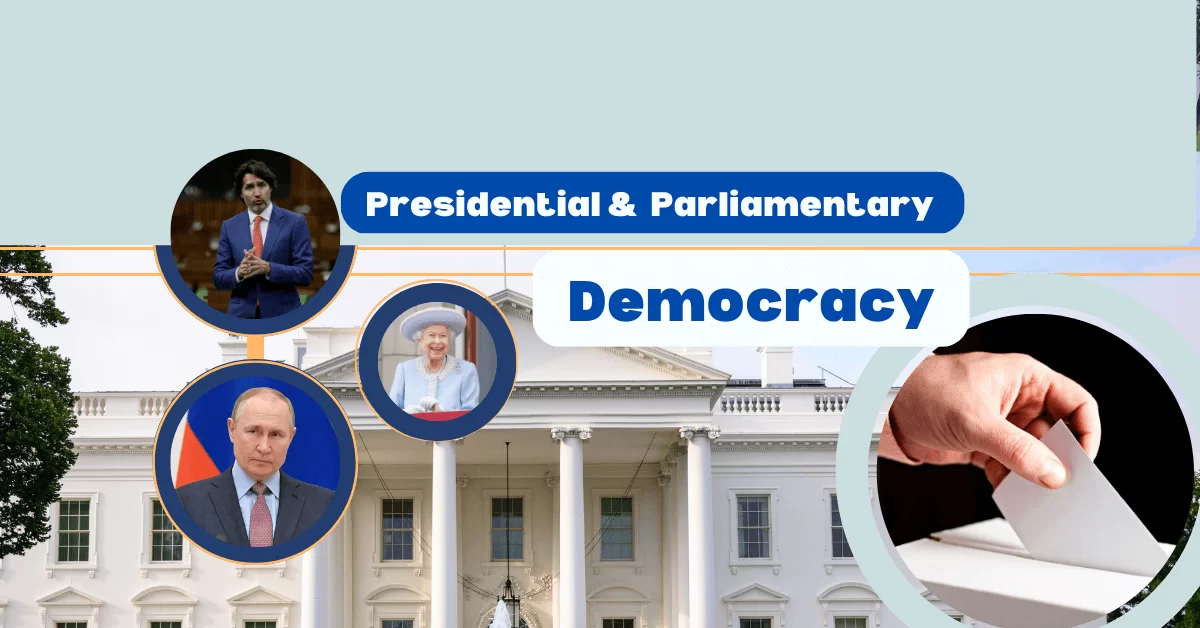A government’s form determines its structure, functions, and powers. There are two dominant forms of government – Presidential and Parliamentary. Both systems have their unique characteristics and are designed to serve different purposes. This article examines the differences between presidential and parliamentary forms of government.
Democracy: Democratic System
Democracy is a system of government in which power is held by the people, either directly or through elected representatives. In a democratic system, citizens have the right to participate in the decision-making process through free and fair elections, the freedom of speech, and the right to assemble and protest.
Democracy typically involves a set of principles and values, including the rule of law, equality, transparency, and accountability. These principles help ensure that the government is responsive to the needs and interests of the people, and that the rights of all citizens are protected.
One of the key benefits of democracy is that it allows for peaceful transfer of power and provides citizens with a say in how their government is run. However, democratic systems can also face challenges such as political polarization, corruption, and the influence of special interests. It is important for citizens to remain vigilant and actively participate in the democratic process to help ensure its success.
Direct Democracy
Direct democracy is a form of government in which citizens participate directly in decision-making processes rather than delegating their power to elected representatives. In a direct democracy, citizens are given the opportunity to vote on proposed laws, policies, and other matters of public concern.
Direct democracy can take many forms, including town hall meetings, citizen assemblies, and online voting platforms. One of the most common examples of direct democracy is the referendum, which is a direct vote on a specific issue or policy proposal.
While direct democracy can be seen as a way to increase citizen participation and accountability, it also has its limitations. Direct democracy may not be practical for large-scale decision-making or complex policy issues, and it can be time-consuming and resource-intensive to organize and conduct citizen participation processes. Additionally, some critics argue that direct democracy can lead to the tyranny of the majority, in which minority voices and interests are not adequately represented.
Representative Democracy
Representative democracy is a form of government in which citizens elect representatives to make decisions on their behalf. In this system, citizens have the ability to participate in the political process by choosing who will represent them in government.
Representative democracy is based on the principle of popular sovereignty, which means that the people hold ultimate power in the government. Elected representatives are accountable to the people they represent and must act in the best interests of their constituents.
In a representative democracy, citizens have the right to vote and participate in the political process, but they do not have direct control over the government’s decisions. Instead, they elect representatives to make those decisions for them.
Representative democracy is the most common form of democracy in the world today. It is used in many countries, including the United States, the United Kingdom, Australia, and Canada.
Presidential Form of Government
In a presidential form of government, the president is the head of state and the head of government. The president is elected by the people and holds the office for a fixed term. The president has executive powers and is responsible for the administration of the government. The president is assisted by a cabinet of ministers who are responsible for various departments.
One of the significant advantages of a presidential system is the separation of powers. The executive, legislative, and judicial branches are distinct, and each has its powers. The president has the power to veto legislation passed by the legislature, but the legislature can override the veto with a two-thirds majority. The president has the power to appoint judges and other officials, but the appointments require the approval of the legislature.
However, the separation of powers can also be a disadvantage. The system can lead to gridlock if the president and the legislature are from different parties and are unable to agree on issues. The president cannot dissolve the legislature and call for new elections, and the legislature cannot remove the president from office except through the process of impeachment.
Parliamentary Form of Government
In a parliamentary form of government, the head of state is separate from the head of government. The head of state is a ceremonial figurehead, such as a monarch or a president, and has limited powers. The head of government is the prime minister, who is the leader of the political party or coalition with the most seats in the parliament. The prime minister is responsible for the administration of the government.
One of the significant advantages of a parliamentary system is the fusion of powers. The executive and legislative branches are combined, and the prime minister is a member of the parliament. This integration ensures that the government has the support of the legislature, and policies can be implemented quickly. The prime minister can dissolve the parliament and call for new elections if the government loses the support of the legislature.
However, the fusion of powers can also be a disadvantage. The government may become too powerful, and there may not be sufficient checks and balances. The opposition may have limited power to challenge the government, and the prime minister may be able to pass laws and policies without sufficient scrutiny.
Both presidential and parliamentary forms of government have their strengths and weaknesses. The choice of system depends on the needs of the country and its people. The presidential system is suitable for countries with a strong tradition of democracy and a need for separation of powers. The parliamentary system is suitable for countries that require quick decision-making and a fusion of powers. Ultimately, a government’s form must be effective in delivering good governance, ensuring the rule of law, and protecting the rights and freedoms of its citizens.
What is the difference between a parliamentary government and a presidential government?
A parliamentary government has the executive and legislative branches fused together, with the head of government being the prime minister, while a presidential government has a separation of powers with the president as the head of state and head of government.
What is the difference between parliamentary and semi presidential system?
The main difference between a parliamentary system and a semi-presidential system is that in a semi-presidential system, the president and prime minister share executive power, whereas in a parliamentary system, the prime minister is the head of government and holds executive power.
Which is the best example of a representative democracy?
One of the best examples of a representative democracy is the United States of America. The U.S. government is structured around a federal system with three separate branches: the executive, legislative, and judicial. Citizens elect representatives to serve in Congress, and the president is elected by the people to serve as the head of the executive branch. The judiciary is appointed by the president and confirmed by the Senate. The U.S. system allows for a separation of powers and checks and balances, which ensures that no single branch of government has too much power.
Which type of government best describes how the country of England is ruled?
England is ruled by a parliamentary system of government, specifically a constitutional monarchy. The head of state is the monarch, and the head of government is the Prime Minister. The government operates under a parliamentary democracy, where citizens elect members of Parliament (MPs) to represent them and make decisions on their behalf. The Prime Minister and Cabinet are appointed from the MPs who have the support of the majority in Parliament.


